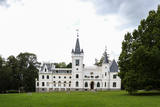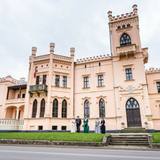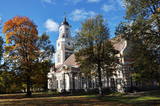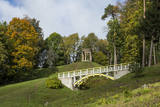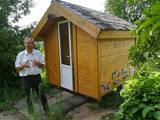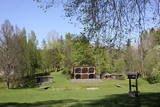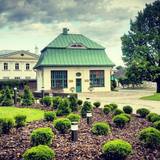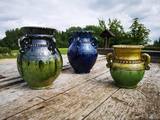Kontaktinformācija
Saistītie objekti
| Foto | Nosaukums | Apraksts |
|---|---|---|
|
Meklējams Jaunpiebalgas dienviddaļā, Jaunpiebalgas vidusskolas teritorijā (no skolas uz dienvidiem). Tas atklāts 1977. g. senā lauku mājā, kuru klāj niedru jumts. Muzeja ekspozīcija stāsta par apkaimes ievērojamākajiem cilvēkiem, notikumiem, vēsturi un tradīcijām. |
||
|
Šaursliežu dzelzceļa līnijas posms ar sliežu platumu 750 mm, kas savieno Alūksni un Gulbeni, ir daļa no kādreizējā Stukmaņu–Valkas dzelzceļa līnijas. Šobrīd tas ir Latvijā vienīgais funkcionējošais regulārās pasažieru satiksmes šaursliežu dzelzceļš. Bānītis kursē katru dienu. Alūksnes dienviddaļā celto Alūksnes stacijas ēku atklāja 1903. g. 33 km garo līniju, kurā ir 10 stacijas un pieturas punkti, bānītis veic ~ pusotras stundas laikā. Populāri ir ikgadējie Bānīša svētki, kas pulcina mazbānīša entuziastus. Vasaras sezonā tiek piedāvāti speciālie tvaika reisi ar restaurēto tvaika lokomotīvi “Ferdinands”. |
||
|
Celta 19. gs. pirmajā pusē Tjūdoru neogotikas formās. Pils pirmais īpašnieks bija barons Johans Gotlībs fon Volfs. Tā paša gadsimta 70. - 80. gados to pārbūvēja franču neorenesanses stilā. Revolūcijas laikā (1905. g.) pili nodedzināja, bet to atjaunoja, ieviešot tās veidolā jūgendstila formas. Gulbenes novada pašvaldība pēdējo divu gadu laikā ir veikusi atjaunošanas un restaurācijas darbus Stāmerienas pils fasādei, jumtam un logiem. Pils ir atvērta apmeklētājiem. Katru dienu noteiktās stundās uz pils ziemeļu fasādes ir skatāma multimediāla ekspozīcija par par Volfu dzimtu. |
||
|
Alūksnes Jaunā pils celta 19. gs. vidū, viens no ievērojamākajiem vēlās Tjūdoru neogotikas arhitektūras pieminekļiem Latvijā. Pils iekštelpas sevī slēpj dažādu arhitektūras stilu mākslinieciskos sienu un griestu gleznojumus, no kuriem daļa ir atsegta. Pils telpās ir iekārtots un Alūksnes muzejs ar ekspozīcijām par pilsētas kultūrvēsturiskā mantojuma īpatnībām un tā daudzveidību un Dabas muzejs “Vides labirints”. Pie pilis piegulošais Muižas parks ir veidots kā dabisks ainavu parks, kas kalpo kā lieliska izvēle mierpilnai pastaigai. Tas ieskauj tādus mazās arhitektūras meistardarbus, kā Aleksandra paviljons, sengrieķu Vēju dieva Eola templis, Putnu paviljons, granīta obelisks, Pomonas templis, baronu dzimtas mauzolejs un no viena granīta gabala veidots strūklakas baseins un granīta soli. |
||
|
Baznīca atrodas pašā pilsētas centrā. Tā celta laikā no 1781. līdz 1788. gadam un tās celšanas iniciators bija Alūksnes muižas īpašnieks Oto Hermanis fon Fītinghofs, tās arhitekts – Kristofs Hāberlands. Noskatītā vieta, netālu no ezera, bijusi purvaina. Tādēļ uzbērts uzkalniņš un baznīcas pamatiem izmantoti divi tūkstoši ozolkoka pāļu. Tā būvēta klasicisma stilā no vietējā laukakmens. Baznīcas apmeklētāji var aplūkot gan grezno interjeru, gan uzkāpt 55,5 m augstajā torni, no kura paveras skaists pilsētas skats. Baznīcas apmeklējums ir jāpiesaka iepriekš. |
||
|
Alūksnes muižas parks atrodas pilsētas austrumu daļā un aizņem 25,54 hektārus lielu platību. Tas ir atzīts par skaistāko parku Vidzemē un ikviens, kas tajā pabijis, ir sajutis parka burvību un skaistumu. Parkā ir saglabājušās vairākas mazās arhitektūras formas. Ieeja parkā ir no Alūksnes Jaunās pils puses. (Avots: Alūksnes TIC) |
||
|
Atrodas Inešu centrā, 5 km uz dienvidiem no Vecpiebalgas. Muižas pirmsākumi meklējami 17. gs. otrajā pusē - 19. gs., kad Orisāres (Orizāre, Arisa) upītes krastos 1786. g. tapusi klasicisma stilā celtā grāfu Šeremetjevu pils. 1905. g. nemieros to nodedzināja, bet četrus gadus vēlāk atkal atjaunoja. Muižas kompleksu ieskauj regulāra plānojuma ainavu parks. Pirms došanās uz šejieni, pārlasām „Mērnieku laikus”, jo Vecpiebalgas muiža kalpojusi par Slātavas muižas prototipu. 1992. g. vīna pagrabā izveidoja Piebalgas novada muzeju. Savukārt muižas pilī darbojas arī Inešu pagasta padome un Porcelāna apgleznošanas studija. Interesanti var doties organizētā ekskursijā pa muižu un tās apkaimi. |
||
|
Viena no skaistākajām Latvijas pilīm (eklektisma stils), ko pils saimnieks Ādolfs fon Vulfs esot uzdāvinājis savai sievai. Pēc arhitekta H. Grīzebaha projekta amatnieki to uzcēla laikā no 1893. - 1896. g. Šobrīd norit pils atjaunošanas darbi. Pie pils Sūlas upītes krastos plešas Cesvaines parks, kur atrodas ar mežu apaugušais Cesvaines pilskalns ar pils īpašnieka Ādolfa fon Vulfa kapu. Pili ir vērts izstaigāt gidu pavadībā. Cesvaines Pils jumta pārbūves darbi ir noslēgušies. Pils ir pieejama apmeklētājiem Cesvaines Tūrisma centra speciālistu pavadībā, piesakoties pa tālr. 26172637 vai Pils ielā 2. |
||
|
Ceļš, kas ved uz Biksēres muižu, atgādina šauru kalnu ceļu ar dziļu upītes gravu. Biksēres muižas patiesais nosaukums ir Libes muiža, kuras tagad redzamās ēkas piederējušas muižkungam Magnusam. Muižas kungu mājas neogotiskā stila tornīti mākslas zinātāju aprindās sauc par arhitektonisku kuriozu. Kungu mājā, kas šobrīd tiek atjaunota, atrodas Sarkaņu pagasta pārvalde. Muižas klētī vietējais entuziasts Andris Trečaks ir savācis seno priekšmetu kolekciju. Pie klēts paveras ļoti plašs skats uz Lubāna līdzenumu. |
||
|
"Saulrietos" (3 km no Vecpiebalgas centra), kas atrodas ainaviskā vietā - Incēnu kalnā, ir izveidots leģendārās latviešu pasakas "Kaķīša dzirnavas" autora Kārļa Skalbes (1879 - 1945) memoriālais muzejs. Tas atrodas 1926. g. celtajā dzejnieka un prozaiķa vasaras namā (pavadīja vasaras laikā no 1926. - 1944.g.) un darbojas kopš 1987. g. Blakus esošā Vaktskalna rietumu nogāzē (skaists skats uz Alaukstu) 1992. g. pārabedīja urnu ar Zviedrijā mirušā Kārļa Skalbes un viņa dzīvesbiedres - Lizetes Skalbes pelniem, kur izveidots savdabīgs piemineklis akmens laivas formā. |
||
|
The first church in Vecpiebalga was built in 1345, and the next one was built between 1839 and 1845 by the Livonian builder Mārcis Sārums. The church was destroyed in 1944 and restored between 1995 and 1997 (architect Ausma Skumiņa). The altar painting is titled “Christ Walking in the Land of Piebalga.” Outside the church is a rock to commemorate those who suffered from political repressions in Latvia. |
||
|
Temple Hill is steep (with artificially created steepness) and about 30 m high, and it is opposite Marijas Island. It is an ancient Lettigalian castle hill, 80 m long and 40 m wide, with several artificial ramparts. One of the oldest objects found in the region is an axe from the 2nd to 3rd millennium BC. Archaeologists believe that the island was populated at that time. There was a Lettigalian castle on the hill during the 10th and 11th century, but it was sacked by the Holy Crusade. The surface of the castle hill was transformed comparatively recently in 1807, when a granite rotunda was built there in honour of Russian Field Marshall Sheremetev and Swedish captain Wulff. The view of Lake Alūksne and the town is one of the most beautiful ones in all Vidzeme. The Sun Bridge (1937) is also worth a look. A wooden viewing platform is nearby. |
||
|
Possibly the highest bee apiary in the Baltics, about 300 m above sea level. Organic beekeeping products are harvested in Gaiziņkalns and its surrounding area. We offer excursions in the farm, bee apiary workshops, tasting of beekeeping products. |
||
|
“Kalna Kaibēni” is on Kaibēni Hill (226 m above sea level) and 7 km to the West of Ineši. Nominated as Latvia’s oldest memorial museum (1929), this is a place with buildings from the 18th and 19th century. Inside you will see exhibits which speak to the lives and contributions of the schoolteachers and authors Reinis (1839-1920) and Matīss (1848-1926) Kaudzīte. The authentic farm includes a garden which the two brothers planted themselves, and the wooden sculptures which were produced by Krišjānis Kugra present characters from the brothers’ famous novel “Age of the Surveyors”. |
||
|
The church was built from 1801 until 1804 by Fridrihs Veits from Cēsis. At the centre of the altar is a painting, “Christ on the Cross,” which dates to the latter half of the 19th century. The bell was cast in 1895, and the organ was built in 1914. In front of the church is a 1930 monument to those who fell during World War I and Latvia’s liberation battles (sculptor Kārlis Zāle, architect Aleksandrs Birzenieks). Restoration of the façade and interior of the church was finished quite recently. |
||
|
The owner of the Stāmeriena Estate was Baron Johann Gottlieb von Wolff, and his wife, Sofia Potyomkina, was a member of the Russian Orthodox faith, so work on the church began in 1902. It was consecrated two years later. The crosses on the steeple of the church are known for mountain crystals that were presented by the Wolff dynasty. Contact the church in advance for a tour of its interior. |
||
|
You can visit the workshop, watch the craftsman at work, try your own hand at the process, and purchase clay objects, including garden ceramics. There is also a lovely garden to view. |
||
|
The Lejasciems cemetery festival *Object Inactive*
|
Lejasciems is unique in that people from all over Latvia congregate there during the mid-summer to take part in a cemetery festival. |
|
|
The potters engage in traditional pottery from various eras, and they also study ancient forms, materials and methods which ancestors centuries ago put to use. You can tour the facility, examine the kiln, work with clay, purchase ceramics products, and inspect a collection of ancient tools and ceramics. You are invited to attend the opening of the kiln, as well. |
||
|
The 11 buildings of the museum feature farm equipment, horse-related equipment, several dozen internal combustion motors, as well as tools used by craftspeople and farmers during Latvia’s first period of independence. The annual harvest festival brings together as many as 2,000 visitors. A harvest festival features special porridge. Groups can take part in a bread programme, watching the production of bread from dough to loaf. |
||
|
Here you will find everything that you need for a proper Latvian sauna – bowls, scoops, tubs large and small, switches, linen products and log saunas as such. You can tour the workshop, try out your own hand at the work that the owners do, and commission or purchase their products. |
||
|
To the North of the Cesvaine Castle is a park that is crossed by the rapidly flowing Sūla River. The Cesvaine castle hill is on the northern bank of the river, is around 15 m high and is covered by trees today. The grave of the owner of the castle, Adolf von Wolff, is there. It is said that he wanted to have his casket dragged to the gravesite on a sled. He died during the summer, but that was done anyway. The park features a wide diversity of trees and bushes, some of which the owner brought home from his extensive travels. |
||
|
"Piebalga medus" is located in Vecpiebalga region, turning off the highway Cēsis – Vecpiebalga – Madona (P30). Beekeeping, apitherapy and narration "About and around bees". Tasting and purchase of beekeeping products. A candlestick workshop is available for visitors. Especially with the fact that the apiary only with Latvian hives. |
||
|
The location requires a drive through the Pērlis forest and sparsely populated areas. Silmači features an open-air stage, which was built in the 1980s for just one performance that was staged by the Latvian National Theatre during the Summer Solstice celebration in 1986. Ever since then, Rūdolfs Blaumanis’ famous play “Tailor Days at Silmači” has been performed here during the season. Alongside the stage is a museum that features information about the single performance in 1986. An original manuscript of the play (1902) can also be viewed. |
||
|
Near Karva along the old Alūksne-Ape road, the monument was unveiled on November 12, 1937. It was designed by the architect Verners Vitands and contains the text “Soldiers from the Valmiera Brigade who fell during Latvia’s liberation battles in 1919; I rested my head on the moss and defended my fatherland.” The monument was torn down in 1975 and restored in 1944. |
||
|
Information about this stream dates back to the mid-18th century, but people used it much earlier than that. People donated money to the stream after washing or drinking the water. During the first half of the 19th century, the baron of Tirza and the local church waged a battle against pagan traditions, though not very successfully. There is now a canopy over the stream, and people still drink its water. |
||
|
The monument is on a hillock along the lovely shores of Lake Alūksne and alongside Pleskavas Street (P 40). The monument was unveiled on June 20, 1923, by Latvian President Jānis Čakste and was designed by the sculptor Jūlijs Miesnieks. It features a shield with crossed words, and the text reads “For fallen soldiers from the 7th Sigulda regiment, 1919-1920), and on the other side there is a text “Better to take my head than our fatherland.” The monument was torn down during the Soviet occupation (1953) and restored in 2009. |
||
|
Kakaiši is found 1 km to the South-West from Vecpiebalga, in the tiny village of Kakaiši. The Latvian writer Antons Austriņš (1884-1934) was born there and went to school in Vecpiebalga. Austriņš is best known for the short story collection “Puiškans” (1931). The museum features various rural objects, things associated with the author, and exhibits such as his collected works and other books that are worth visiting in the company of a guide. |
||
|
The monument is next to the Vecpiebalga Cultural Centre. Its architect was Ausma Skujiņa, and the sculptress was Maija Eņģele. |
||
|
Located at Pils Street 25A in Alūksne, this is a building that was initially a trade pavilion and was built in the early 20th century. The Ernst Glück Bible Museum was established in 1990 as the only museum of its type in Latvia and the Baltic States. Glück (1652-1705) was a pastor and educator who was the first to translate the Bible into Latvian. The exhibition features various editions of the Bible from 1694 to the present day in 38 languages, along with books of sermons and other examples of Christian literature. |
||
|
You can visit the workshop, watch the craftsman at work, try your own hand at the process, and purchase clay objects, including garden ceramics. There is also a lovely garden to view. |
||
|
Organic farming principles which maintain the biological diversity of the surrounding region will be explained to visitors during a tour which also offers consultations on environmentally friendly farming. Organic produce is available for purchase, and visitors can relax on the waterside - fishing, enjoying a sauna and making use of local accommodations. A herd of wild cattle can also be observed.
|
||
|
This museum is along the road from Jaunpiebalga and Vecpiebalga and was opened in 1969. It focuses on the life and work of two distinguished Latvians – the composer Emīls Dārziņš (1875-1910) and the poet and writer Jānis Sudrabkalns (1894-1975). It features items related to the lives of the two men. Music by Dārziņš can be heard in the museum, tours are offered to individual visitors and groups, and thematic and musical events are held at the museum. |
||
|
The museum at Egļava has an exhibition about forestry in Latvia before and after World War II. The exhibit features forestry tools and equipment, as well as textiles from the former Balvi District along with samples of ceramics and woodworking. The former forest ranger house has rooms to provide accommodations to guests. |
||
|
“Vēveri” is located 7 km to the North of the centre of Vecpiebalga and offers a look at typical and authentic farms and craftsmen’s operations from the Piebalga landscape in the 19th century. You will wee ancient tools and household objects, as well as a recently restored windmill. |
||
|
The craftsman produces pottery typical of Vidzeme, but with the range of colours that is typical of Latgale. These products fit in very nicely with the lovely landscape of Racupkalns. You can take a tour, watch the master at work, and work with clay yourself. You can also watch as he opens a Lettigalian ditch kiln. You can commission and purchase the products, as well. |
||
|
This is one of the rare cases in which we know precisely when the trees were planted. It was in 1685 and 1689, and they were planted by the priest of the local congregation, Ernest Johann Glück (1654-1705) in commemoration of the fact that he had completed the translation into Latvian of the Old Testament and the New Testament respectively.
|
||
|
Ethnographic and household storage in Sarkaņi offers craft tools collection, furniture and household collection, 19th and the end of the 20th century living room furnishings, and the exhibition dedicated to Madona countrymen. (Source: Madona TIC) |
||
|
A renovate estate complex of the 19th century in the historical centre of Gulbene town. The hotel offers 14 rooms with conveniences, 9 hostel rooms and the guest house „Siernīca” with a fireplace room. A conference room and equipment, a fireplace room for 40 persons, a festivity room, cafe and bar. Outdoor tent for festivities.
|
||
|
The Old School of Druviena is alongside the Druviena-Liezēre road. The historical school building became home to a museum in 1964. The school is closely linked to the great Latvian writer Jānis Poruks (1871-1911), and a memorial room to him has been installed in the building. On the second floor, you can look at a classroom, sit on an old-time school bench and try to imagine yourself as a schoolchild long ago. Interesting exhibits include boxes in which children brought food from home – the same ones which were used by two of Poruks’ most popular characters, Cibiņš and Buņģis. |
||
|
This saloon is located 5 km from Madona and at the edge of a highway in the forests of Smecere – the 37th kilometre of the Pļaviņas-Gulbene road. The building in which the saloon is housed was built in the 17th century, and today it is home to a modern leisure complex made up of a three-star hotel, a saloon and cafe, and a music club. |
||
|
The Livonian Order built a fortified castle on the largest island in Lake Alūksne – Marijas Island (Pilssala Island) in 1342. It was linked to the land by a 120 m drawbridge. The castle had several forecastles, and it was regularly modernised and expanded until the end of the 17th century. It was one of the largest Livonian Order Castles, with similar ones found in Vastelina and Izborsk. Defensive barriers were put up around the castle, which survived until the Great Northern War. Its central part was blown up by the defeated Swedish military in 1702, after which Russians completely sacked it. All that is left are the castle ruins on the island, which is now linked to Alūksne and Temple Hill by two wooden bridges. An open-air stage alongside the castle ruins is used for various public events. |
||
|
This is one of the oldest museums in Vidzeme and features interesting discoveries from the Middle Ages and the Iron Age, some of which were found around Lake Lubāna. Employees organise thematic exhibitions related to the culture and history of the administrative district, as well as art exhibitions. The museum is in the historical buildings of the former Birži Estate. |





